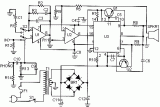High Quality unit. No need for a preamplifier.
Amplifier parts:
P1 22K Log.Potentiometer (Dual-gang for stereo)
R1 560R 1/4W Resistor
R2,R3 10K 1/4W Resistors
R4 12K 1/4W Resistor
R5,R6 2R2 1/4W Resistor
R7 22R 1/2W Resistor
C1 1uF 63V Polyester Capacitor
C2,C3,C4 100uF 25V Electrolytic Capacitors
C5 22pF 63V Polystyrene or Ceramic Capacitor
C6 22uF 25V Electrolytic Capacitor
IC1 LM833 or NE5532 Low noise Dual Op-amp
Q1,Q3 BC337 45V 800mA NPN Transistors
Q2,Q4 BC327 45V 800mA PNP Transistors
J1 RCA audio input socket
Power supply parts:
R7 2K2 1/4W Resistor
C7,C8 2200uF 25V Electrolytic Capacitors
D1 100V 1A Diode bridge
D2 5mm. or 3mm. Red LED
IC2 7815 15V 1A Positive voltage regulator IC
IC3 7915 15V 1A Negative voltage regulator IC
T1 220V Primary, 15 + 15V Secondary 5VA Mains transformer
PL1 Male Mains plug
SW1 SPST Mains switch
Notes:
Can be directly connected to CD players, tuners and tape recorders.
Tested with several headphone models of different impedance: 32, 100, 245, 300, 600 & 2000 Ohms.
Can drive old 8 Ohms impedance headphones, but these obsolete devices are not recommended.
Schematic shows left channel and power supply.
Numbers in parentheses show IC1 right channel pin connections.
A correct grounding is very important to eliminate hum and ground loops. Connect in the same point the ground sides of J1, P1, C2, C3 & C4. Then connect separately the input and output grounds at the power supply ground.
Technical data:
Output voltage: Well above 5V RMS on all loads
Sensitivity: 250mV input for 5V RMS output
Frequency response: Flat from 30Hz to 20KHz
Total harmonic distortion @ 1KHz & 10KHz: Below 0.005% on 32 Ohms load and up to 4V RMS output (typical 0.003%)
Total harmonic distortion @ 1KHz & 10KHz: Below 0.005% on 100 to 2000 Ohms load and up to 5V RMS output (typical 0.003%)
Unconditionally stable on capacitive loads
Author: RED Free Circuit Designs
Email:
Website: http://www.redcircuits.com/

 Audio
Audio







